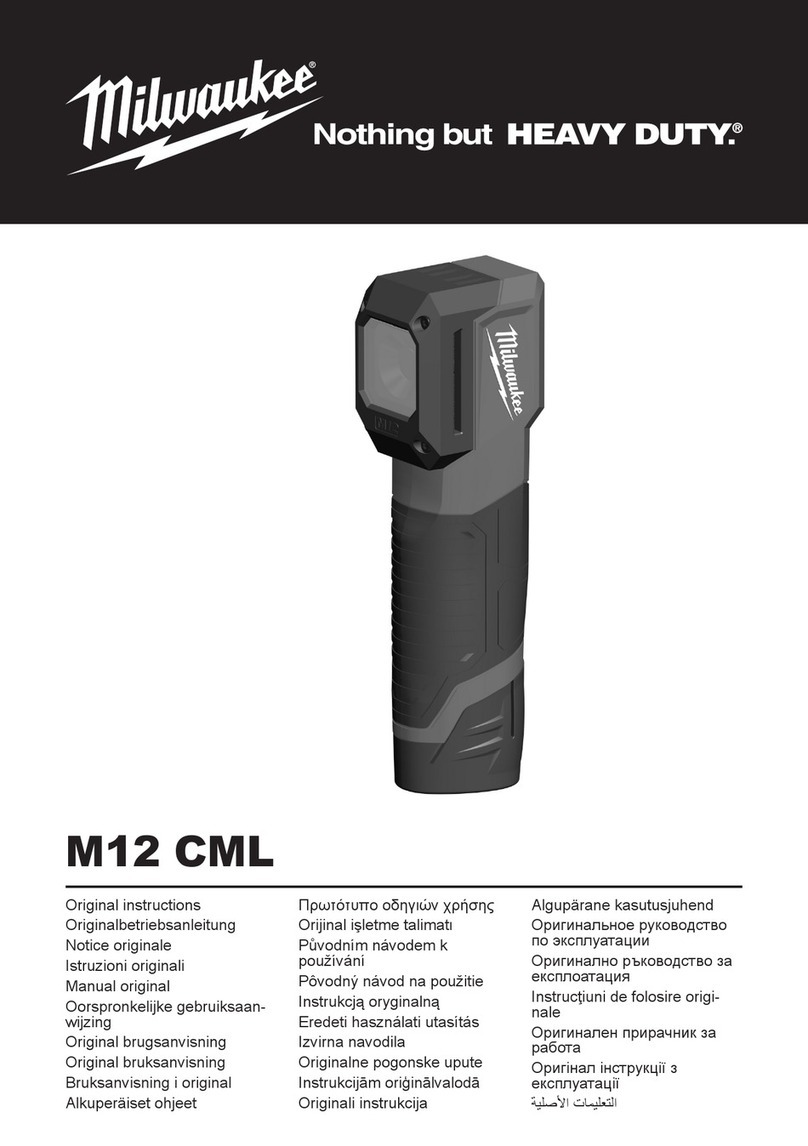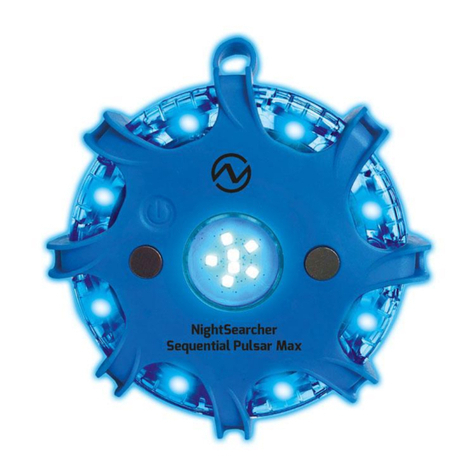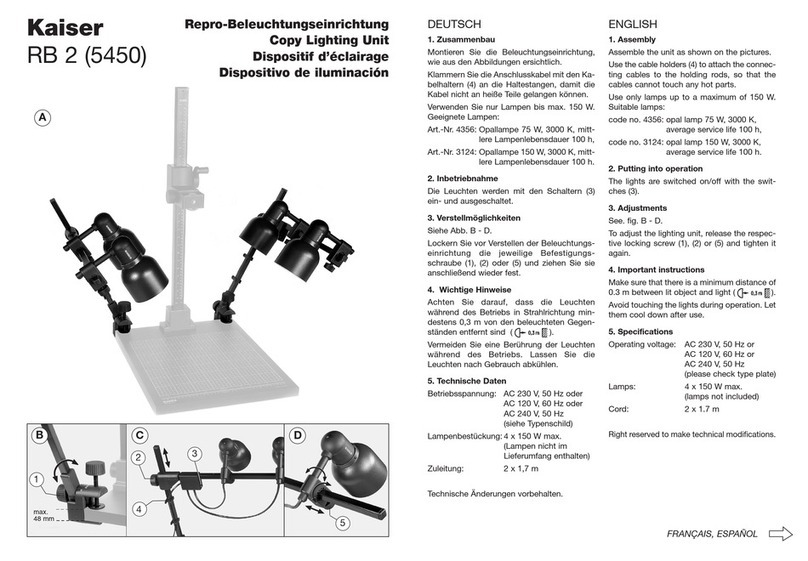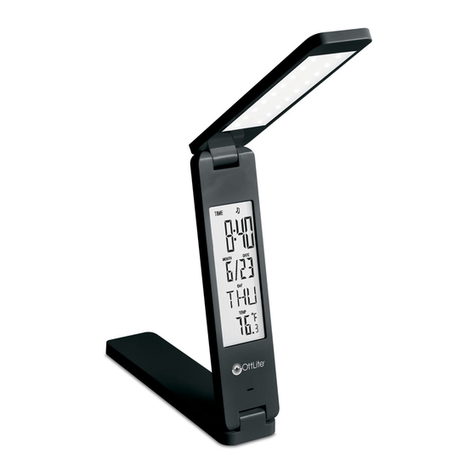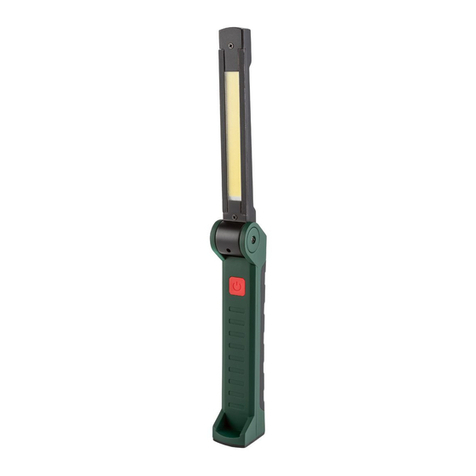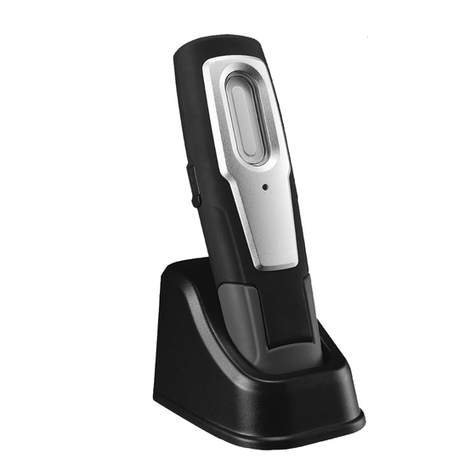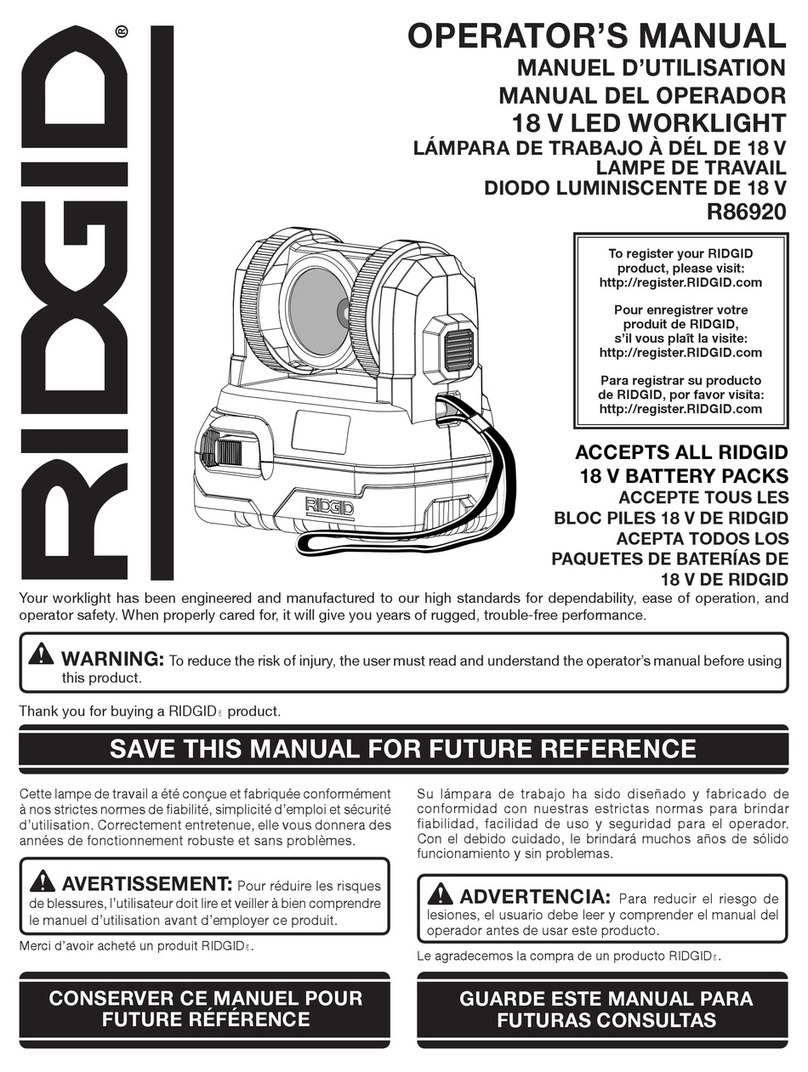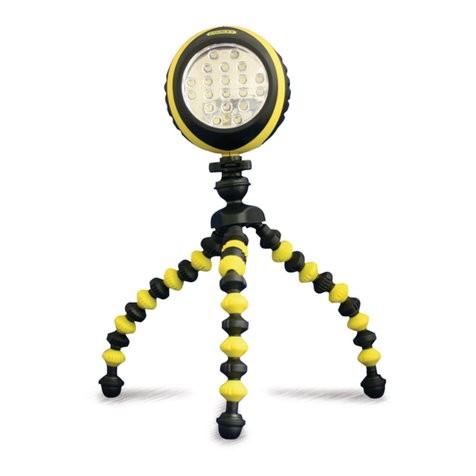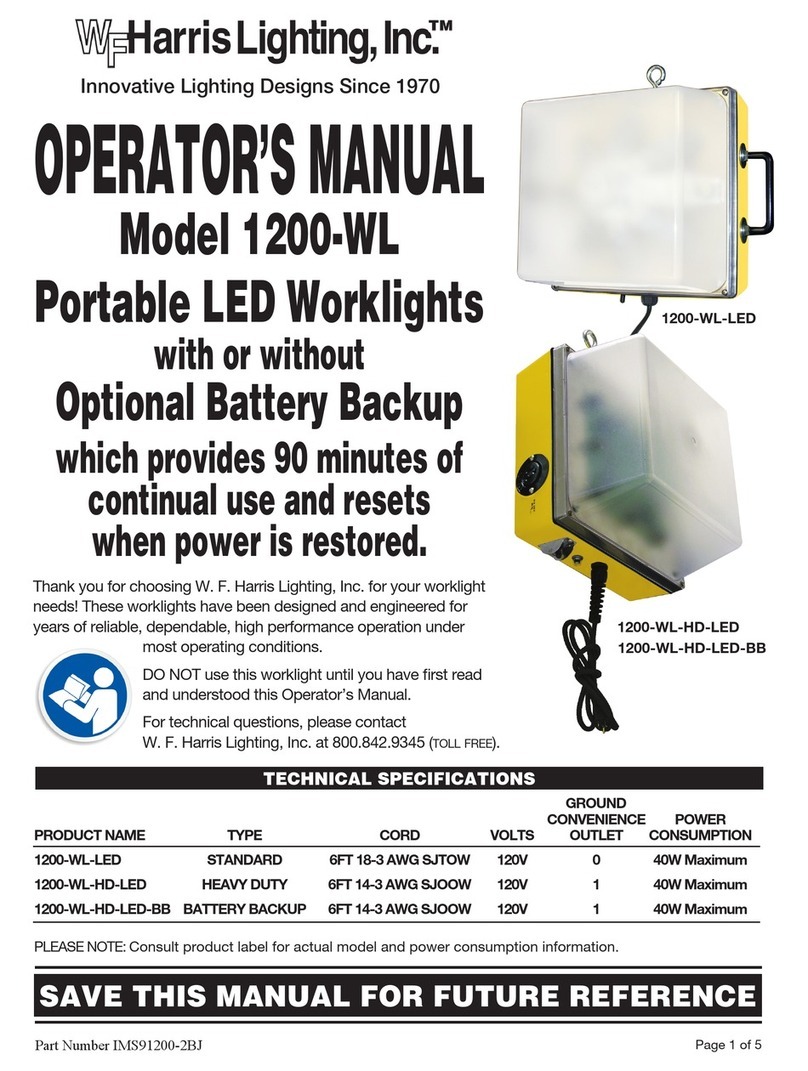Denchi Oldham DL16 User manual

1
DL16 - Issue 4 November 2023
WARNING
This manual, including the warnings and cautions inside, must be read and followed carefully by all
persons who use or maintain this product, including those who have any responsibility involving its
selection, application, service, or repair.
This cap lamp system will perform as designed only if used and maintained according to the instructions,
otherwise it could fail to perform as designed and persons who rely on this product could sustain serious
personal injury or death.
DL16
CAPLAMP SYSTEM
WITHOUT COMPROMISE
INSTRUCTION
MANUAL

2
DL16 - Issue 4 November 2023
DL16 CAP LAMP SYSTEM
TABLE OF CONTENTS
Important p3
General description p3
Preparation for use p3
Battery charging p3
Cap lamp system p4
Battery Storage p4
Replacing battery p4
Removing cable from battery p4
Replacing battery cover p4
Using DL16 cap lamp systems p4
Repairing headpiece p5
Replacing cable p5
Replacing reflector p5
Replacing circuit board p5
Reassembling bezel ring p6
Replacing the Lock Barrel P6
DL16 diagram –Item list p7
Parts diagram p8
Troubleshooting p10
Use of Equipment p11
Special Conditions for Safe Use p12
Appendix: Commissioning & Charging Instructions p13

3
DL16 - Issue 4 November 2023
IMPORTANT
Pay close attention to Warnings and Cautions in
this manual.
A WARNING describes a condition that may cause
severe personal injury or death if allowed to
happen.
A CAUTION describes a condition that may cause
moderate injury or property damage if allowed to
happen.
GENERAL DESCRIPTION
The DL cap lamp systems consists of a cap
mounted headpiece powered by a Li Ion battery.
The basis of the headpiece in which some of the
internal connections are integral is as follows:
A selector switch is incorporated, which can switch
on either the main LED light source or the small
emergency LED. The reflector fits over the small
LED and has a rubber gasket around the rim to seal
against the headpiece lens.
PREPARING THE DL6 CAP LAMP FOR FIRST
TIME USE
The battery is packaged separately to the lamptop
and needs to be connected before use.
Tool kit required is 206008
NOTE: THE BATTERY IS TRANSPORTED IN A
PARTIALLY CHARGED CONDITION - EVERY
BATTERY MUST BE FULLY CHARGED
BEFORE FIRST USE.
Remove the battery from the shipping box and
check for damage. The battery is supplied with the
encapsulated fuse fitted, terminal nuts and
washers.
Remove the nut and washer from the positive end
of the fuse (marked +). Place the ring terminal of
the red wire onto the terminal post, replace the
spring washer and nut, and tighten to 0.5Nm.
Remove the nut and washer from the negative
terminal (not connected to the fuse) and place the
ring terminal of the black wire onto the terminal
post, replace the spring washer and nut, and
tighten down to 0.5Nm.
Hook the cable exit end of the battery cover onto
the battery.
Check that the cables are not trapped under the
edge of the cover then press down into position.
Secure the cover in place with the clip and M4
mushroom head socket screw.
➢Battery charging
WARNING
Li Ion batteries must only be charged on a
specific charger with a Li Ion charge profile.
Use of unapproved chargers may result in
damage to the caplamp’s battery protection
circuit.
For charger information and how to convert
existing charger software please consult the
Caplamp Charger Manual.
Every battery must be charged before it is used for
the first time.
Never discharge completely!
IMPORTANT NOTE:
The battery is supplied with a factory fitted
“OCBL-T” fuse (203500), required for
protection of the internal battery circuitry.
Use of any other fuse type could result in
damage and will invalidate any warranty claim.

4
DL16 - Issue 4 November 2023
Charging before first use:
1. Allow the battery to remain on charge for 24
hours.
2. After a working shift, the battery should be
placed on the charger, following the
instructions included with the charger, and left
to charge. The charger automatically switches
off when the battery is completely charged
3. If cap lamp needs cleaning, use a mild
detergent and wipe. Do not submerge in water.
(see appendix –pg.12 - for full commission &
recharge instructions)
➢Battery Storage
All stored batteries should be given a 24-hour boost
charge 3 months after receipt and thereafter at 6-
monthly intervals until use, where they should
again be fully charged before being placed into
regular service.
Recommended storage temperature: 0oC to 27oC.
➢Replacing battery
1. Remove one M4 button head socket screw
from the end clamp holding the cover as
shown.
2. Un-clip the clamp and slide off the cover to
cable end.
3. Remove the positive cable lead (red)
4. Remove the fuse
5. Remove the negative lead (black)
➢Replacing battery cover
1. Replace the fuse; fit the nuts to hold the fuse in
place
2. Connect the red cable to the positive battery
terminal.
3. Connect the black cable to the negative battery
terminal to ensure correct polarity.
4. Tighten the cable leads down with terminal
nuts to 0.5Nm.
5. Replace the battery cover.
6. When the fuse is removed the safety circuit will
activate. Place battery on charge before use.
Note:
Ensure that the cable leads lie properly on the
battery top without being trapped or pinched.
USING THE DL16 CAP LAMP SYSTEM
The DL headpiece is made up of the lamp-housing
which contains the following parts:
-Bezel (ring)
-Lens (glass)
-Gasket
-Reflector
-Main LED
-Secondary LED
-Circuit board and switch
The on-off-on switch knob is located on the
headpiece. The down position operates the main
LED and up position the secondary LED.

5
DL16 - Issue 4 November 2023
➢Repairing the headpiece
TOOLS:
G & D type spares and tools kit –206008
D type Headpiece fastening & cable lock kit -
201536
The switch should be placed in the off position and
the battery fuse removed (see section “cap lamp
system”) before disassembly of the headpiece.
➢Replacing Cable
1. Remove the cable from the battery terminals.
2. Cut the cable tie around the cable under the
battery cover and pull the cable out from the
battery cover gland.
3. Unscrew the M3 socket head mushroom screw
from the headpiece cable lock.
4. Use a small screw driver to “flick” the cable lock
off the retaining boss. Take care not to lose the
o-ring under the boss as this is required for
reassembly.
5. Replace the mushroom head socket screw.
This is important to ensure the circuit board
support in the headpiece does not become
loose.
6. Hold the lens glass down while unscrewing the
bezel ring.
7. Remove the lens glass and reflector.
8. Unscrew the 2 off M3 slotted screws.
9. Remove the cable
10. To replace the cable reverse the above
procedure.
Note:- Always ensure that one screw is fixed
into the positive cable terminal or the cable
lock. This ensures the circuit board support
does fall out of position.
WARNING
It is essential that all contacts in the headpiece
are tight, so that no electrical resistance is
incurred which might increase the time
necessary to obtain an efficient charge or
possibly reduce the light output of the lamp.
➢Replacing the reflector
1. Remove the bezel ring and lens.
2. Remove the reflector
3. Remove gasket around reflector.
4. Place the gasket around the new reflector.
The reflector is located by two projections
which fit either side of the main LED; the hole
in the reflector goes over the secondary LED
.
The bezel ring should be screwed down firmly
while holding the glass down with your thumb.
5. Reassemble the lens and bezel ring (see
“Reassembling the bezel ring”).
➢Replacing the circuit board
The LE CC driver circuit board can be replaced in
the event of damage to the switch or electronic
failure of the board. This procedure should be
carried out by a person with experience of
soldering on small circuit boards.
1. Remove the cable as described above
2. De-solder the wire connections to the LED at
the circuit board.
3. Carefully bend the cables away from the
circuit board.
4. Use an open ended spanner 206002 to
remove the nut securing the switch. Remove
the washer and rubber backed sealing
washer.
5. Pull the old circuit board out from the front of
the main housing.
6. Put a 10mm spacer in the positive hole
before replacing the board.

6
DL16 - Issue 4 November 2023
7. Replace the circuit board, pull in the threaded
switch boss to ensure it is fully located in the
socket at the back of the headpiece housing.
Ensure the circuit board is correct.
8. Replace the sealing washer and nut, tighten
with the open ended spanner.
9. Re-solder the wires from the main LED.
10. Replace the cable and reassemble the
reflector, lens and bezel ring.
➢Reassembling the bezel ring
1. When the lens is in position over the reflector,
the bezel ring is screwed onto the headpiece
housing, and locked in position by the
stainless steel cable lock.
2. Ensure the cut-outs in the bezel ring line up
with the cable lock.
3. Hook the cable lock into the slot under the cap
hook support. Press down so the cable is in
position, replace the o-ring and then clip over
the boss on the side of the headpiece.
4. Secure with M3x10 mushroom-head screw.
➢Replacing the lock barrel
If the lock barrel is damaged it may become difficult
to connect the lamp to the charger. In this case, the
lock barrel must be replaced (201538 –lock
contact spares kit).
1. Undo the M4 lock nut and remove the dome-
head screw that runs through the charging
contact housing.
2. The metal cap-clip can be lifted off and set to
one side (take care not to lose the spring clip).
3. Remove the lock barrel and ensure that the
charging contact housing is clear of any debris
before inserting the replacement lock barrel.
4. Holding the lock spring in position, refit the cap-
clip cover, insert the dome-head screw and re-
tighten the M4 lock nut.

7
DL16 - Issue 4 November 2023
DL16 Expanded Diagram, Tools and Spare Parts List
200000 (M261551)
DL16 caplamp (complete)
201000
D-type Lamptop complete
(with cable and battery cover)
201000 (M261951)
L16 Type battery
201526 (M259121X)
Bezel ring (D-type)
201504 (M200131X)
Glass lens
201508 (M200411X)
Sealing channel
201527 (M259127X)
Reflector (D-type)
201529 (M259383)
LED CC circuit board
201540 (M260116)
Cable 1.6m (D-type)
203500 (M455323FX)
Fuse (type OCBL-T)
201536 (M259683)
D-Type Headpiece Fastening & Cable Lock kit
201524 (M205083)
D and G Cable Terminal Spares kit
201520 (M204683)
D and G Lock Contact Spares kit
201521 (M204783)
D and G Cap-clip Spares kit
201545 (M455045)
Plastic Battery Cover (complete)
Clip for standard cover
Screw for plastic cover
Cable gland
Cable tie
206008 (M614830)
Small tools and spares kit, suitable for all “G” and
“D” type lamps comprising :-
Cable outlet gland key
Allen key for headpiece lock pin
Insulated screwdriver
Spring screwdriver
Spanner for L16 battery terminal nuts
Spanner for D-type switch
Two “OCBL” battery fuses
Note: Only certain replacement items above may
be purchased individually. All others, as noted
above, must be purchased in kit form as this
ensures that other associated parts are also
available for replacement at the same time as part
of an appropriate preventative maintenance
programme.

8
DL16 - Issue 4 November 2023

9
DL16 - Issue 4 November 2023

10
DL16 - Issue 4 November 2023
TROUBLESHOOTING
PROBLEM
CAUSE
LED is dim or fails to light
1) Both LED’s are dim / fail to light
2) Main LED is dim / fails to light
1. Loose connections:
a. Check the connections on the top of the battery to
make sure they are tight.
b. Check the headpiece terminals and the electrical
connections inside the headpiece in the same manner
as those on the battery.
2. Loose connections:
a. Gently wiggle or pry each connection on top of the
battery to make sure it is tight and working properly.
b. Check the cables for broken conductors by twisting or
pulling it at various points along its length.
c. Check the headpiece terminals and the electrical
connections inside the headpiece in the same manner
as those on the battery.
d. Make sure the bulb is secure and making good
contact.
e. If the light flickers or dims when any of the preceding
items are being checked, that item should be repaired
or replaced.
Battery appears “dead” and will not operate
a. Check that the fuse has not blown
b. Check the cross volts of the battery, if no voltage is
recorded the Safety Circuit has activated either
because the fuse has been disconnected or blown or
the battery has been over discharged.
c. After checking continuity across the fuse, place battery
on charge (switched off) and leave for 10 seconds.
Disconnect then reconnect, the charger should then
initialise the charge regime and the battery will
recharge normally.
Battery capacity
a. The 9Ah battery is designed for8-hour operation and
the 16 Ah Li Ion battery is designed for 12 hour
operation. Failure to achieve this is probably due to a
high resistant joint in the circuit.
b. Check Headpiece charging connections
c. Check charger.
d. Check battery connections.
IMPORTANT : ALWAYS RECHARGE THE LAMP AFTER USE.
ENSURE THAT ONLY CHARGERS WITH THE
CORRECT LI-ION CHARGE PROFILE ARE USED.

11
DL16 - Issue 4 November 2023
Certification and equipment marking and instructions:-
Lamp Type Nomenclature Reference:-
The lamp nomenclature indicates the battery, battery cover and headpiece type that are combined
to make the complete caplamp.
The full designation is DPL16, but since battery covers are now only available in plastic, the
designation is commonly abbreviated to DL16.
The assembly combination should not be changed without consultation of Denchi Group Ltd.,
Caithness, Scotland.
The type code sequence is as below:-
1 2 3
Headpiece type Battery Cover type Battery type
DStandard PPlastic Cover L16 Li Ion Battery
AATEX M1 LHand Lamp E16 Li Ion Battery ATEX M1
R Remote Take Off
1 2 3
Sample type code:- D P L16

12
DL16 - Issue 4 November 2023
Use of equipment:-
The user must ensure that the lamp supplied meets the safety standard required for the work
environment, with specific note to Zoned or Hazardous designated areas:-
1. Check that the operating temperature range is in the range 0oC to +40oC for Mining.
2. The lamp must not be disassembled in any hazardous area.
3. The lamp must not be charged in any hazardous area.
4. The battery casings are manufactured from polycarbonate and ABS with nitrile rubber
seals. The performance of these materials, with respect to attack by aggressive
substances that may be present in the operating environment shall be taken into account
before the equipment is used.
5. Plastic surfaces may cause propagating brush discharges. Propagating brush discharges
are caused by non-conducting fluid flow over a non-conducting plastic surface. The cap
lights shall not be used in areas where a high fluid flow over the plastic surfaces may occur
(for example in the case of a ruptured process pipe or compressed air pipe).
Special Conditions for Safe Use:
There are no special conditions stipulated.
Denchi Group Ltd.
Denchi House, Thurso Business Park,
Thurso, Caithness, KW147XW
URL: www.oldhamcaplamps.com
Tel.: +44 (0)1847 808000
November 2023

13
DL16 - Issue 4 November 2023
Appendix –LITHIUM-ION BATTERY COMMISSIONING & CHARGING INSTRUCTIONS
The Oldham D-type and A-type (LED) cap lamps are designed to operate at full light intensity for a full 12-hour shift. At the end of
each shift the lamp should be recharged on an approved Oldham micro-processor caplamp charger.
Note: To comply with IATA transport regulations, all li-ion batteries are shipped in a 30% state of charge condition and will
require a full 12-hour charge before being put into service
For 12-hour operation, the charger types 204001 or 204002 for the L16 & E16 batteries are recommended
(2-channel lamp & 10-channel chargers respectively).
PREPARING THE CAP LAMP FOR FIRST TIME USE: DL16 and AE16 lamps
The lamptop and battery are shipped unassembled to comply with international transportation regulations.
Tools required to assemble the lamp are an M4 for nut spinner for the battery terminals, and a 2.5mm
Allen socket key to secure the battery cover. (available in our “Small Tools and Spares Kit” part no.
206008).
Assembly of the DL16 and AE16 lamps.
1. The fuse is pre-fitted to the battery.
2. From the lamptop supplied, fasten the red cable to “+”positive terminal and the black cable to
the negative “-“ terminal with the washer and M4 nut, tightening to 0.5Nm
3. Hook the battery cover onto the battery at the negative end and press down ensuring the cable
is not trapped. (NB./ see picture –battery face/label toward you, cable should exit to the left)
4. Secure with the clamp at the positive end and lock with the M4 Mushroom headed socket screw.
Battery charging
1. Every battery must be charged before it is used for the first time.
2. Insert the headpiece over the charging key (headpiece held upside-down), and rotate the lamp
clockwise (approx. 2/3rd of a turn) until it can not turn any further, making +/- contacts.
3. Allow the battery to remain on charge for 12-24 hours. Note: Batteries which do not perform
satisfactorily, should be removed from service and subjected to a cycle charge process: charge
for 16 hours and discharge for 8 hours. Repeat several times until battery responds.
4. If battery does not respond after three or four cycles, it should be replaced.
Never discharge completely!
5. Lamps should be recharged each time after use, but after weekly shifts have been completed, the battery should be placed
on the charger (following the instructions included with the charger) and left to charge for the remainder of the weekend.
6. Oldham microprocessor chargers provide a maximum 4.20v / 1.0A to the lamp for recharge. USB style chargers delivering
5.0V / 1.0A may be used satisfactorily with the understanding that cycle-life will be diminished and warranty is invalidated
If the cap lamp needs cleaning, use a mild detergent and wipe. Do not submerge in water.
STORAGE OF BATTERIES
Lithium-ion batteries have excellent shelf-life with very slow rates of self-discharge. However, in order to maintain optimum condition,
all stored batteries should be boost charged for 24 hours every 6 months, and again immediately before being placed into regular
service.
Recommended storage temperature range: 32 O F to 80 O F / 0Oto 27 O C.
NOTE: Oldham multi-stage microprocessor controlled chargers have been programmed with a charge profile which is specifically
designed to achieve maximum cycle life in the Oldham range of lithium-ion powered caplamps. Operators may choose to recharge
their lamps on non-approved constant potential (voltage) chargers or other equipment, but daily operation and total cycle-life may be
affected.
Denchi Group Ltd. will not accept any warranty claim against lamps used on non-approved chargers
Table of contents
